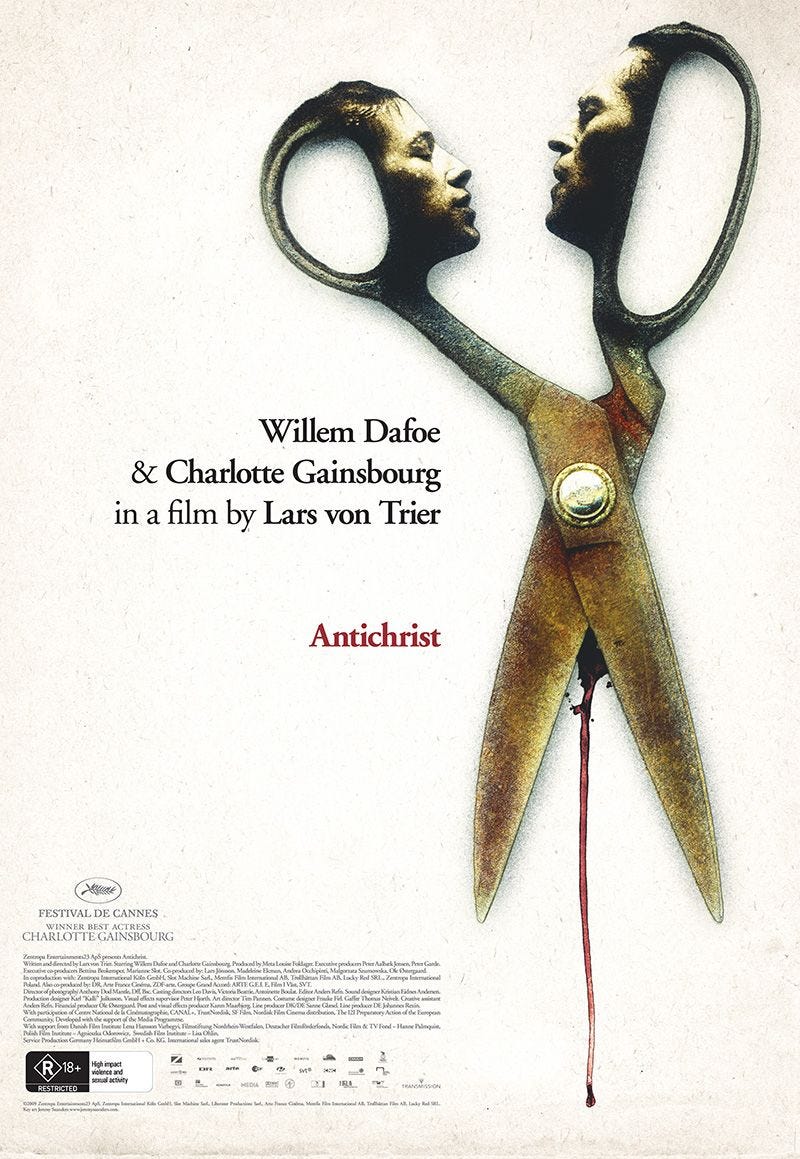
Von Trier’s work may not be for everyone, but it deserves to be taken seriously.Īntichrist was released on Blu-Ray and DVD on Nov. They force viewers to confront the darkness in human nature, while harnessing the duality of gritty realism and deliberately heightened surrealism to create an experience both achingly intimate and viscerally cinematic. Mantle and von Trier’s spellbinding visual poetry, particularly their use of tangled human limbs and fantastical animals, has drawn comparisons to Hieronymus Bosch’s infamous triptych, “The Garden of Earthy Delights.” Yes, von Trier has always worn the title of “provocateur” like a badge of honor, but his films don’t aim to shock simply for the sake of stirring people up. In each film, von Trier has proven his gift for eliciting overwhelming performances from his actors, and the duo of Gainsbourg and Dafoe are no exception. He has always identified more with his female protagonists, who have valiantly struggled in the face of adversity in every one of his pictures, from Emily Watson in “Breaking the Waves” and Bjork in “Dancer in the Dark,” to Nicole Kidman and Bryce Dallas Howard in the “Land of Opportunities” trilogy. Some detractors have hurled at von Trier the tired claim that the abuse inflicted upon his female characters reflects his own “misogyny.” Though the director’s worldview may be dark and pessimistic, his films have always been about abuse, never an endorsement of it. I won’t even mention the particular sequences of violence that most writers seem breathless to reveal.

The controversy surrounding “Antichrist” was so overpowering that it succeeded in drowning out the film itself. Photo credit: Courtesy of the Criterion Collection A fitting alternate title for the film could be, “A Woman Under the Satanic Influence.”Ĭharlotte Gainsbourg stars in Lars von Trier’s Antichrist. The psychological torture he inflicts on her, however naïve and well-meaning it may be, proves to have physical repercussions. Once there, Dafoe begins having ominous visions, as Gainsbourg slowly descends into madness. Her fear of the woods inspires them to take a trip to their country home, cryptically named Eden. Gainsbourg becomes immobilized with guilt and unease, while psychiatrist Dafoe treats her like one of his patients. The slow-motion sequence culminates with the couple’s infant son climbing atop a windowsill and plummeting to his death. Like Andrei Tarkovsky’s “The Mirror,” which served as a primary inspiration for von Trier, “Antichrist” shifts between color and black-and-white with dreamlike ease.

Utilizing his trademark chapter markers, von Trier centers his story on a nameless couple (played by Willem Dafoe and Charlotte Gainsbourg), who are engaged in passionate lovemaking during the film’s prologue, which is exquisitely filmed by cinematographer Anthony Dod Mantle in black-and-white. While the film is certainly not devoid of von Trier’s irony-laced humor, it is also a shattering meditation on the debilitating grief that comes from devastating loss, and the destructive toll that it has on the body and soul.
ANTICHRIST MOVIE SON CLIMBS FREE
Using this latest effort as a catalyst to free him from paralyzing depression, von Trier delved into his own lifelong struggles with anxiety, exorcising his psychological demons onscreen. It’s a sad day in film criticism when a daring and exhilarating work of art like Lars von Trier’s “Antichrist” is widely labeled as a “joke” directed by a “fraud.” Say what you will about von Trier, but he is nothing if not sincere. This is a much scarier premise, since the greatest horrors externalized in the film are spawned entirely from the woman’s unstable psyche, deranged by guilt. “Antichrist” is about a woman who isn’t possessed, but is nevertheless absolutely convinced that she is an instrument of the devil.

CHICAGO – One of the most reliable scenarios in the horror movie playbook is the satanic possession of a human character.


 0 kommentar(er)
0 kommentar(er)
